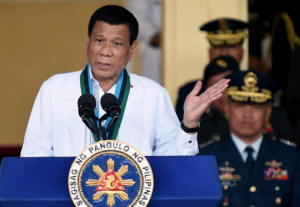|
Philippines takes 'appropriate action'
over Chinese bombers in disputed South China Sea
 Send a link to a friend
Send a link to a friend
 [May 21, 2018]
By Manuel Mogato [May 21, 2018]
By Manuel Mogato
MANILA (Reuters) - The Philippines
expressed "serious concerns" over the presence of China's strategic
bombers in the disputed South China Sea and its foreign ministry has
taken "appropriate diplomatic action", the spokesman of President
Rodrigo Duterte said on Monday.
China's air force said bombers such as the H-6K had landed and taken off
from islands and reefs in the South China Sea as part of training
exercises last week, drawing angry reactions from opposition lawmakers
in Manila. The United States also sent ships to the disputed areas.
The Philippines could not independently verify the presence of Chinese
bombers in the South China Sea, said presidential spokesman Harry Roque.
"But we take note of the reports that appeared and we express our
serious concerns anew on its impact to efforts to maintain peace and
stability in the region," Roque told a regular media briefing at the
presidential palace.
The Department of Foreign Affairs in the Philippines said it was
monitoring developments.

"We are taking the appropriate diplomatic action necessary to protect
our claims and will continue to do so in the future," it said in a
statement, but it did not elaborate.
However, the foreign ministry stopped short of condemning China's
action, which Washington said could raise tension and destabilize the
region.
In Beijing, a foreign ministry spokesman urged other countries not to
over-interpret what he called a routine military patrol.
"We hope that relevant parties do not read too much into this," Lu Kang
told a daily news briefing.
China claims almost the entire South China Sea, a strategic waterway
through which about $3 trillion worth of sea-borne goods pass every
year. Brunei, Malaysia, the Philippines, Taiwan and Vietnam also have
conflicting claims in the area.
China has built seven artificial islands in the Spratlys group in the
South China Sea and turned them into military outposts with airfields,
radars, and missile defenses.
[to top of second column]
|

Philippines President Rodrigo Duterte gestures during an armed
forces change of command ceremony at Camp Aguinaldo in Quezon City,
Metro Manila, Philippines April 18, 2018. REUTERS/Dondi Tawatao/File
Photo

Beijing says its military facilities in the Spratlys are purely
defensive and it can do what it likes on its own territory.
Roque and foreign ministry officials said Manila would raise China's
moves to militarize its manmade islands in the Spratlys during
two-way consultations in China set for the second half of the year.
Lawmakers in the Philippines have criticized Duterte for setting
aside an arbitration ruling by the Hague the country won in 2016.
Former foreign minister Albert del Rosario has urged Duterte to
"revisit" the country's foreign policy.
"We are opposed to war - as we should be. But if threatened by the
use of force, we should be ready to inflict, at the very least, a
bloody nose on any attacker who is out to harm us," Del Rosario said
in a statement.
Duterte has said he would not risk a confrontation with China and
has reiterated his openness to joint exploration and development in
waters believed to be rich in oil and natural gas.
(Reporting by Manuel Mogato; Additional reporting by Ben Blanchard
in BEIJING; Editing by Michael Perry and Clarence Fernandez)
[© 2018 Thomson Reuters. All rights
reserved.]
Copyright 2018 Reuters. All rights reserved. This material may not be published,
broadcast, rewritten or redistributed.
Thompson Reuters is solely responsible for this content.
 |